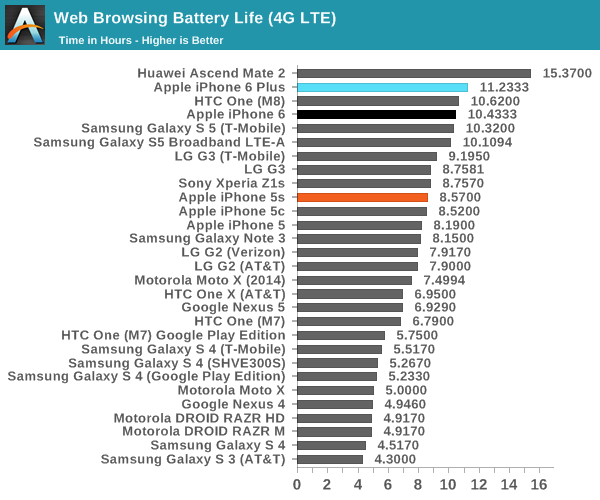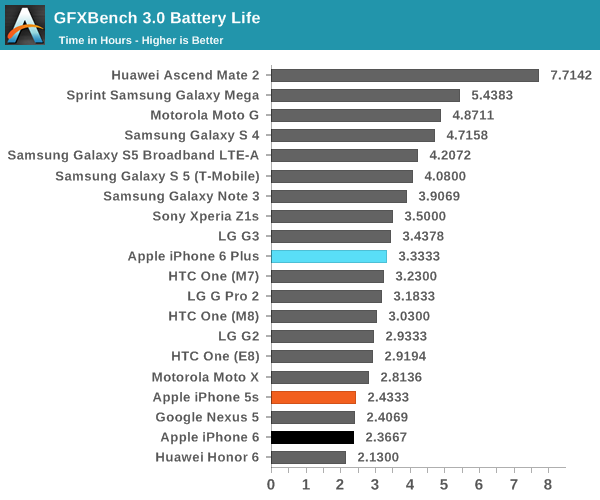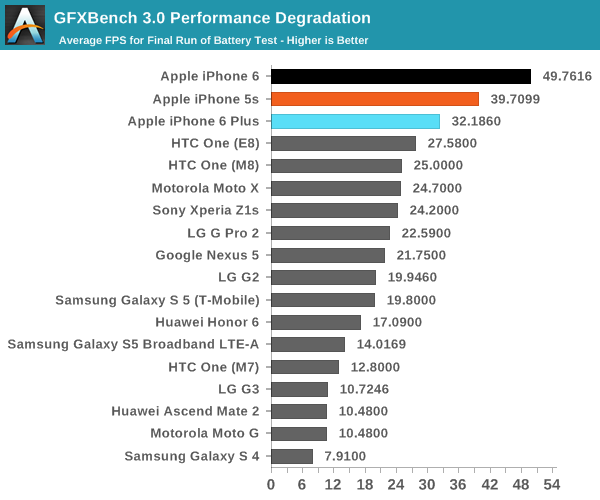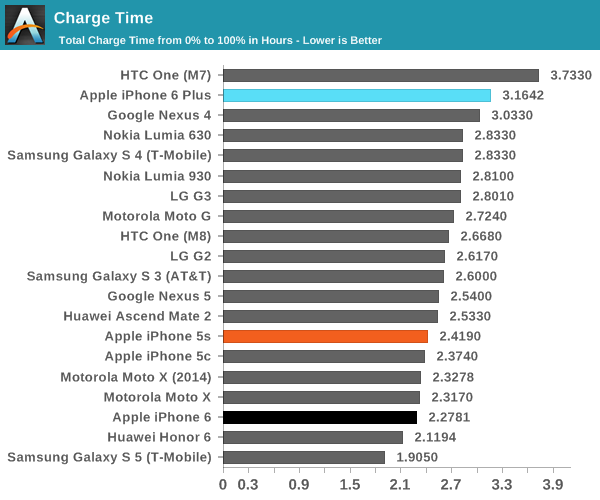The iPhone 6 Plus Mini-Review: Apple's First Phablet
by Joshua Ho on September 30, 2014 8:00 AM EST- Posted in
- Smartphones
- Apple
- Mobile
- iOS
- iPhone 6 Plus
Battery Life
One of the big draws of the larger form factor is battery life. Due to fundamental scaling issues, a bigger phone should be able to achieve greater battery life than a small one. This is because a smartphone's PCB generally remains constant in size, so it becomes an increasingly smaller proportion of the overall device size. This leaves increasingly large areas where batteries fill in the gap. In order to quantify just how big of a difference this makes when going from 4.7" to 5.5", we turn to our standardized battery life test suite. For those unfamiliar with our testing, the display is calibrated to 200 nits and all background tasks are disabled in order to ensure that only the foreground task is active in our tests.

As we previously discussed, the iPhone 6 Plus performs quite admirably in the WiFi web browsing test. As expected, there's a healthy bump over the iPhone 6, but it's not quite a massive leap as a larger battery size might suggest.

Once again, we see a similar pattern with the LTE web browsing test. Since both phones are based on the same platform, it makes sense that their results track quite closely together as we're only scaling display and battery size within the context of these tests.
However, the web browsing test is a mostly display-bound test, even if there is an SoC efficiency aspect that can make a significant difference. In order to better test SoC efficiency and get an idea of the dynamic range that a phone has in battery life, we turn to our compute-bound tests. Unfortunately, Basemark OS II stops the test too early due to low battery notifications in iOS, so we cannot use that test for a proper comparison to other phones.


As shown in these charts, the iPhone 6 Plus manages to sustain a significant boost in battery life when compared to the iPhone 6, and performance is almost identical as well. It seems that the iPhone 6 Plus begins to throttle towards the end of the test simply because it has more time to generate heat rather than any real difference in cooling, as skin temperatures were also around 43C on the iPhone 6 Plus in this test. It's also important to note that the iPhone 6 Plus is rendering at 2208x1242 internally in order to keep proper scaling with the 163 points per inch system that iOS has, which accounts for part of the performance delta.
Overall, battery life on the iPhone 6 Plus ranges between about 20% higher to 40% higher depending on the balance of display power and SoC/baseband power in any given situation. Heavily display-bound situations will be closer to the 20% higher figure while more SoC-bound tasks will tend toward 40% or even higher. Purely idle situations should see even greater improvements as any situation where the display is off will see linear scaling with battery size.
Charge Time
Charge time is one of the key metrics for getting a holistic picture of battery life, as it's impossible to really understand whether a phone will be able to stay mobile as needed without considering recharging. In some cases such as a trade show or travel, it doesn't matter if a phone lasts 20% longer than the competition if it loses all the time gained in time spent on a charger. In order to test this, power is tracked from when the phone is connected to the charger to when it reaches the lowest power draw state on the AC adapter.

Unfortunately, the included charger is the same 5W charger that we've seen for years now. As a result, the iPhone 6 Plus is constrained by the relatively low maximum power that it can put out. Those that wish for faster charging should look into getting an iPad A/C adapter as the iPhone 6 Plus will charge faster when connected to it.










191 Comments
View All Comments
trynberg - Tuesday, September 30, 2014 - link
"They always make sure they come up with the first of its kind"????Hello, mainstream Android has had screens larger than 4" and phablets for 3 years. Many of the features in iOS 7 and iOS 8 were directly cribbed from Android. Apple has a nicely curated experience but give me a break.
trynberg - Tuesday, September 30, 2014 - link
No mention of any of the software bugs? No mention of apps not working properly with the new screen. A blanket assertion at the end of the review that says this is the best phablet with zero justification as to why this is better than a Note or G3?I would think Anandtech would work extra hard to make sure they are neutral towards Apple when your owner and another long term writer both left to work for Apple. This review doesn't come across as neutral.
There are legitimate criticisms of any phone, Android, WP, or Apple, and I didn't see any listed here.
cwolf78 - Tuesday, September 30, 2014 - link
Exactly. I've been slowly questioning the credibility of this site more and more. There was an obvious Apple bias when Anand and Brian were still here. I was hoping that would stop when they left. But I see more of the same. I'm not disputing that the iPhone 6 Plus is a great phone in its own right, but to say it's the best "phablet" on the market when it doesn't even have any demonstrable phablet capabilities? There's a lot more to a phablet than having a bigger screen. How about a stylus? Multi-window or split-screen support? Actual real multitasking? How about taking notes or sketching? How in the hell is this the best phablet on the market? You can't just claim something like that without backing it up and expect to be taken seriously.joe_dude - Wednesday, October 1, 2014 - link
There has been a slight pro-Apple bias ever since Anand started using Macs years ago. But it was never really an issue, since the testing was unbiased. Just ignore the pro-Apple conclusions, and it was all good. Glossing over problems is not what Anandtech is (or was) about.nerd1 - Wednesday, October 1, 2014 - link
Anand ALWAYS showed secret apple bias for years, by selecting which results to show etc (He always showed results that are favorable to apple devices). Take a look at the surface 3 pro review. He compares its IPS screen to macbook air's TN screen with TERRIBLE viewing angle and says SP3 has worse color accuracy than MBA.And now it just became more obvious so that anyone can notice. It's sad.
hlovatt - Wednesday, October 1, 2014 - link
You say the Anand review was biased against SP3 yet in the conclusions he says:"I was a fan of the original Surface Pro, and with Surface Pro 3 I think Microsoft has taken the hardware much closer to perfection."
Sounds like he likes it a lot to me. I take it that to you any criticism of the SP3, no matter how minor, is a sign of bias.
If you really want to see bias, I suggest you look no further than the nearest mirror.
nerd1 - Thursday, October 2, 2014 - link
SP3 is the best windows tablet devices ever, and he does not deny that. Yet it is just totally and absolutely absurd to compare SP3's 1440p IPS display to MBA's 900p TN display with terrible, terrible viewing angle. And he did, only showing test results favorable to MBA (like color accuracy when viewed DIRECTLY front of the screen)hlovatt - Thursday, October 2, 2014 - link
I think you see bias everywhere you look.He compared it to a number of devices: MBA, rMBP, and Air. The display of the SP3 came in better than MBA, but worse than the others, and that is what he said:
"Overall the Surface Pro 3 display is a huge improvement over the previous two generations, but it doesn't quite meet the high standards set by some of the other competitors on the market today from both notebook and tablet spaces."
I don't see bias in this, he just chose a number of broadly similar devices that lay from the cheaper MBA and Air to the slightly more rMBP, that seems fair and balanced to me.
GigaMonster - Thursday, October 2, 2014 - link
If you want to use a stylus with your iOS device, use a stylus. They're supported. WACOM makes a very nice 2048 one and plenty of apps make use of its multiple levels of sensitivity.instantchip - Tuesday, September 30, 2014 - link
In case you're conflicted about whether to get iPhone 6 or 6 Plus (like I was), try this quick decision tree to make your pick easier. It's on chipbrown(dot)me.It helped me decide--hope it helps you!